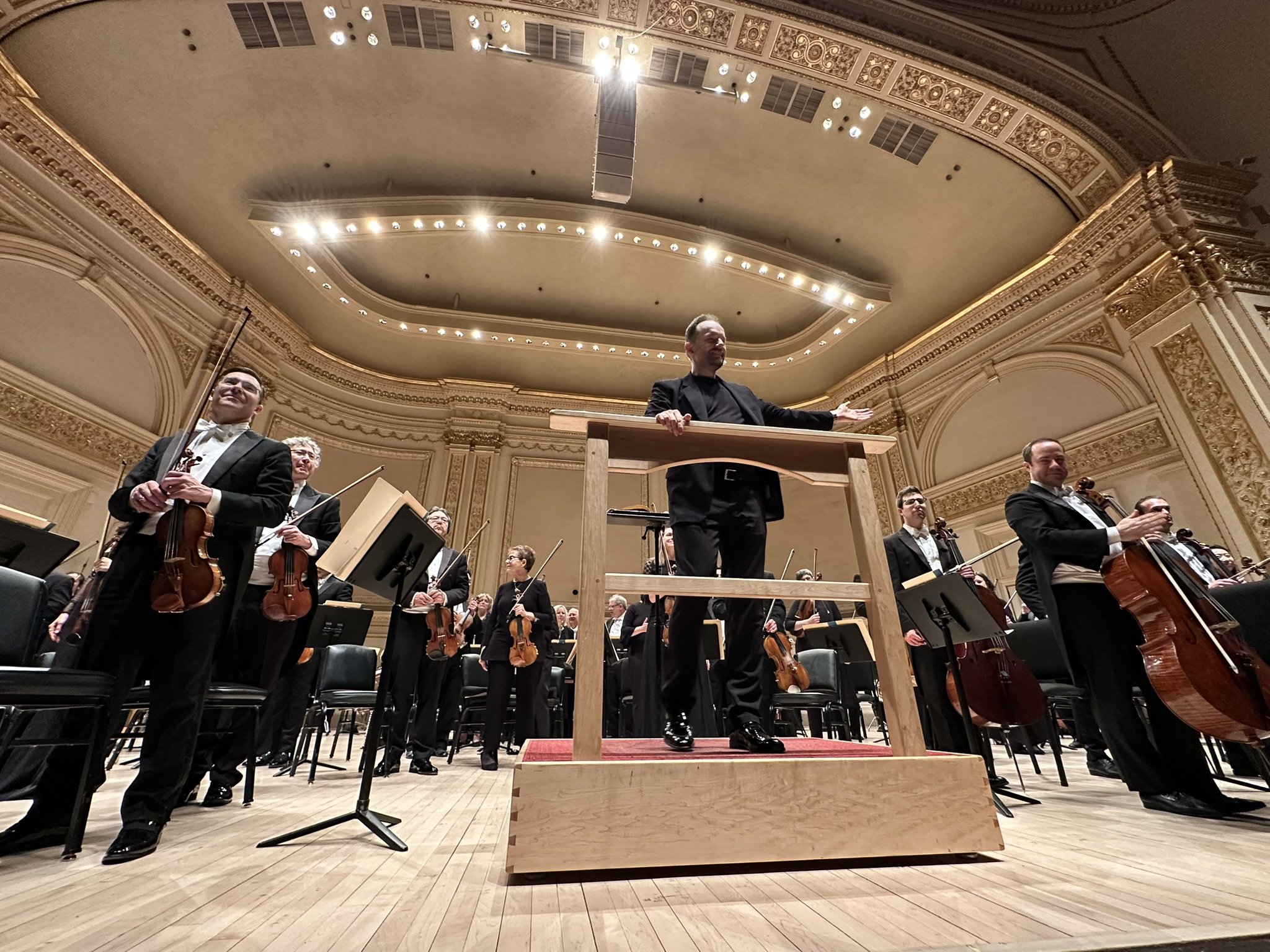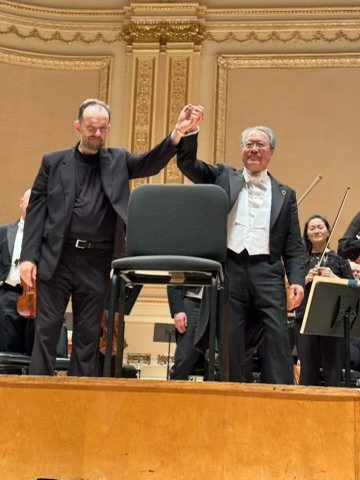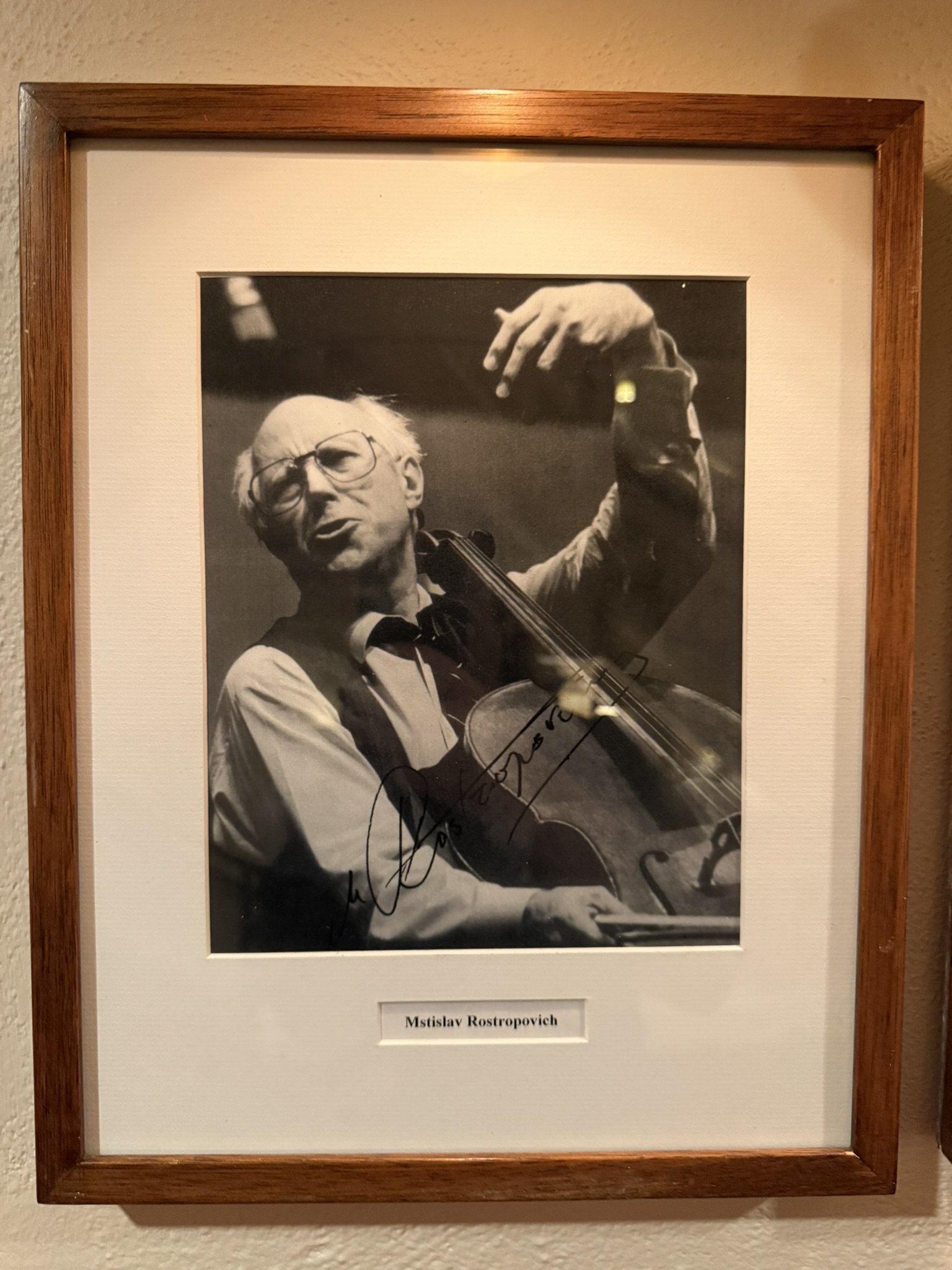The Boston Symphony Orchestra and Andris Nelsons performed at Carnegie Hall on April 24, following their appearance the previous day. The program included Shostakovich's Cello Concerto No. 1 and Symphony No. 11. Shostakovich's son, Maxim, was in attendance. The New York Times reviewed the opening of the performance as follows:
“A single death is a tragedy, a million deaths a statistic.” At the start of the Boston Symphony Orchestra’s all-Shostakovich concert at Carnegie Hall on Thursday, the cellist Yo-Yo Ma invoked this darkly cynical statement attributed to Stalin. Addressing the capacity crowd, which included Shostakovich’s son Maxim, Ma added: “We play Shostakovich so that no death is ever just a statistic.”
The program started Cello Concert, composed in 1959 and dedicated to Rostropovich. Shostakovich's son Maxim said in an interview that Shostakovich and Rostropovich were very close. The opening theme is D-S-C-H, the opening syllables of Shostakovich, and this theme resonates throughout the piece. It consists of four movements, including a cadenza, and is performed by a small orchestra that includes one horn. The cello melody has a symbolic sound; the horn alternates with the melody, and the unison of the piccolo and clarinet is also impressive, which, combined with the solo cello, creates irony and grotesqueness. The second movement in particular gives a strong sense of Russian national character and shakes the soul. After the end of Stalin's reign of terror, there was a tendency to quote familiar songs and melodies.
The following Symphony No. 11 depicts the suppression of the people that took place in Moscow in January 1905, one year before Shostakovich was born. It was a Sunday morning in January of the lunar calendar. The protest demonstration of the people gathered in Palace Square was suppressed by military fire. After the quiet and hair-raising opening, string harmonics, flute unison, eerie timpani, trumpet fanfare, and celesta, it seems like a desolate world after the extinction of humanity after a nuclear war. This theme appears repeatedly. The scene of firing defenseless citizens at the command of the state and taking their lives was performed with remarkable unity by the Boston Symphony Orchestra. The snare drum roll, brass, and low strings express the violence and fear of the people under Nelsons, a marvel of an overwhelming orchestra that is cruel, merciless, and unified, no different from Russia today. Even after the performance ended, the snare roll, the icy trumpet fanfare, and the celesta came to mind again and again. I'm happy that this was music. I'm not familiar with the details of the many quotations in this piece, but I believe Shostakovich chose a piece he loved. Shostakovich is said to have depicted an unenlightened past, the awakening of protest, the maturation of revolutionary consciousness, the decisive battle, mourning for heroes who died in battle, and the triumphant dawn of a new era. The finale, known as Nabat in Russian or a warning, features a celesta.
If we make rules, murders become statistics, and no one pays attention if a child goes crazy next to someone concentrating. We live in an age of diversity where people can easily kill others without using weapons. Shostakovich speaks for the anger of the masses. The performance by the Boston Symphony Orchestra and Nelsons clearly showed through music the roots of the dissatisfaction that the masses feel, which is relevant to the modern age.
I hope that Shostakovich's music will lead to the realization of personal happiness that does not cause trouble to others. Russia and America are not so different in the sense that they are both groups of people lacking in morals.
ボストン交響楽団とアンドリス・ネルソンスは4月24日、カーネギーホールで前日に引き続き、演奏会を行った。プログラムはショスタコービチのチェロ協奏曲1番と交響曲11番。会場にはショスタコーヴィチの息子、マキシムの姿があった。ニューヨークタイムスのレビューでは、この公演の冒頭について以下の様に報じている。
「1人の死は悲劇だが、100万人の死は統計に過ぎない。」木曜日、カーネギーホールで行われたボストン交響楽団によるショスタコーヴィチのコンサートの冒頭で、チェロ奏者のヨーヨー・マはスターリンのものとされるこの暗く皮肉な発言を持ち出した。ショスタコーヴィチの息子マクシムを含む満員の観客に語りかけ、マ氏はこう付け加えた。「私たちはショスタコーヴィチを演奏することで、死が単なる統計にならないようにしています。」
1曲目のチェロ協奏曲1番は1959年に書かれ、ロストロポービチに捧げられた。ショスタコービチとロストロポービチはすごく仲が良かったと息子のマキシムがインタビューで話していたそうだ。冒頭のテーマはD-S-C-H、ショスタコービチの始めの綴りで、この主題が作品を通して現れる。カデンツァを含む4楽章で、小さな編成のオーケストラにはホルンが1つ。チェロの旋律を掛け合ったり、変わりに歌ったりと象徴的に聴こえる。ピッコロやクラリネットのユニゾンもとても印象深く、ソロチェロと一緒に皮肉とグロテスクを演出する。特に2楽章では、ロシア民族性を強く感じ魂を揺さぶられるようだった。スターリンの恐怖政治後は、なじみ深い歌や曲を引用する傾向があったそうだ。
続く交響曲第11番は、ショスタコーヴィチが生まれる前年の1905年1月にモスクワで起きた民衆の弾圧を描いている。陰暦1月の日曜日の朝のこと。宮殿広場に集まった民衆の抗議デモは軍の銃撃によって鎮圧された。静かで身の毛もよだつような冒頭の後、弦楽のハーモニクス、フルートのユニゾン、不気味なティンパニ、トランペットのファンファーレ、チェレスタが、核戦争後の人類滅亡後の荒廃した世界を思わせる。このテーマが繰り返し登場する。そして、国家の命令で無防備な市民に発砲し、命を奪っていく場面は、ボストン交響楽団によって驚異的な一体感をもって演奏された。スネアドラムのロール、金管楽器、低弦楽器がネルソン指揮下の民衆の暴力と恐怖を表現し、残酷で容赦なく、そして団結した圧倒的なオーケストラの驚異は、今のロシアと何ら変わらない。演奏が終わっても、あのスネアのロール、トランペットの凍てつくファンファーレ、チェレスタが何度も浮かんできた。これが音楽で本当に良かったと思う。この曲の沢山の引用は詳しくはしらないが、ショスタコービチが愛着ある曲を採用していることを感じる。ショスタコービチは、啓蒙されていない過去、抗議の目覚め、革命意識の成熟、決戦、戦死した英雄たちへの哀悼、そして、新時代の勝利に満ちた夜明けを描いたという。フィナーレはロシア語でNabat、警告とあり、チェレスタが用いられている。
ルールを作れば人殺しも統計になり、真面目に集中している横で子供が暴れても誰の注意もない。武器以外でも人間は簡単に殺せる多様性の時代。ショスタコービチは大衆の怒りを代弁している。ボストン交響楽団とネルソンスの演奏は、そういった現代に通じる大衆が抱える不満の根を鮮明に音楽で見せてくれた。
将来、ショスタコービチの音楽が人に迷惑をかけない個人の幸せの実現につながることを祈ります。ロシアもアメリカもモラルの足りない人間の集まりという意味ではそんなに変わらない。
Boston Symphony Orchestra
Andris Nelsons, Music Director and Conductor
Yo-Yo Ma, Cello
Program
ALL-SHOSTAKOVICH PROGRAM
Cello Concerto No. 1
Symphony No. 11, "The Year 1905"
Encore:
TRAD. "Moyshele" (arr. for cello ensemble by Blaise Déjardin)



